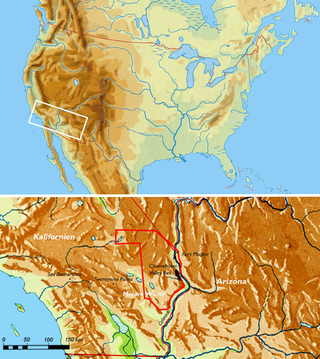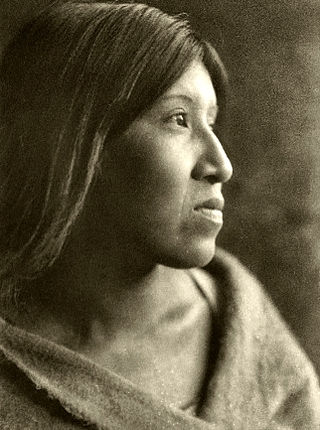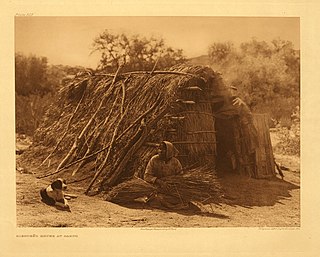Related Research Articles

The Chemehuevi are an indigenous people of the Great Basin. They are the southernmost branch of Southern Paiute. Today, Chemehuevi people are enrolled in the following federally recognized tribes:

The Cahuilla, also known as ʔívil̃uqaletem or Ivilyuqaletem, are a Native American people of the various tribes of the Cahuilla Nation, living in the inland areas of southern California. Their original territory included an area of about 2,400 square miles (6,200 km2). The traditional Cahuilla territory was near the geographic center of Southern California. It was bounded to the north by the San Bernardino Mountains, to the south by Borrego Springs and the Chocolate Mountains, to the east by the Colorado Desert, and to the west by the San Jacinto Plain and the eastern slopes of the Palomar Mountains.

The Cahuilla Band of Indians is a federally recognized tribe of Cahuilla people located in Southern California. They were formerly the Cahuilla Band of Cahuilla Indians of the Cahuilla Reservation.

The Chemehuevi Indian Tribe of the Chemehuevi Reservation is a federally recognized tribe of Chemehuevi people, who are the southernmost branch of Southern Paiute people.
The Sycuan Band of the Kumeyaay Nation is a federally recognized tribe of Mission Indians from Southern California, located in an unincorporated area of San Diego County just east of El Cajon. The Sycuan band are a Kumeyaay tribe, one of the four ethnic groups indigenous to San Diego County.
The Agua Caliente Band of Cahuilla Indians of the Agua Caliente Indian Reservation is a federally recognized tribe of the Cahuilla, located in Riverside County, California, United States. The Cahuilla inhabited the Coachella Valley desert and surrounding mountains between 5000 BCE and 500 CE. With the establishment of the reservations, the Cahuilla were officially divided into 10 sovereign nations, including the Agua Caliente Band.

The Campo Indian Reservation is home to the Campo Band of Diegueño Mission Indians, also known as the Campo Kumeyaay Nation, a federally recognized tribe of Kumeyaay people in the southern Laguna Mountains, in eastern San Diego County, California. The reservation was founded in 1893 and is 16,512 acres (66.82 km2).
The Augustine Band of Cahuilla Indians is a federally recognized Cahuilla band of Native Americans based in Coachella, California. They are one of the smallest tribal nations in the United States, consisting of only 16 members, seven of whom are adults.
California v. Cabazon Band of Mission Indians, 480 U.S. 202 (1987), was a United States Supreme Court case involving the development of Native American gaming. The Supreme Court's decision effectively overturned the existing laws restricting gaming/gambling on U.S. Indian reservations.

The Ramona Band of Cahuilla is a federally recognized tribe of Cahuilla Indians, located in Riverside County, California.
The Cabazon Band of Cahuilla Indians is a federally recognized tribe of Cahuilla Indians, located in Riverside County, California. They were formerly known as the Cabazon Band of Mission Indians.
The Torres Martinez Desert Cahuilla Indians is a federally recognized tribe of Cahuilla Indians, located in Imperial and Riverside counties in California. Their autonym is Mau-Wal-Mah Su-Kutt Menyil, which means "among the palms, deer moon." in the Cahuilla language.

The Morongo Band of Mission Indians is a federally recognized tribe in California, United States. The main tribal groups are Cahuilla and Serrano. Tribal members also include Cupeño, Luiseño, and Chemehuevi Indians. Although many tribes in California are known as Mission Indians, some, such as those at Morongo, were never a part of the Spanish Missions in California.

The Santa Ysabel Band of Diegueño Mission Indians of the Santa Ysabel Reservation is a federally recognized tribe of Kumeyaay Indians, who are sometimes known as Mission Indians.

The San Pasqual Band of Diegueño Mission Indians of California is a federally recognized tribe of Kumeyaay people, who are sometimes known as Mission Indians.

The Mesa Grande Band of Diegueño Mission Indians of the Mesa Grande Reservation is a federally recognized tribe of Kumeyaay Indians, who are sometimes known as Mission Indians.
The Manzanita Band of Diegueño Mission Indians of the Manzanita Reservation is a federally recognized tribe of Kumeyaay Indians, who are sometimes known as part of the Mission Indians.

The La Posta Band of Diegueño Mission Indians of the La Posta Reservation is a federally recognized tribe of the Kumeyaay Indians, who are sometimes known as Mission Indians.

The Barona Group of Capitan Grande Band of Mission Indians of the Barona Reservation is a federally recognized tribe of Kumeyaay Indians, who are sometimes known as Mission Indians.

The Viejas Group of Capitan Grande Band of Mission Indians of the Viejas Reservation, also called the Viejas Band of Kumeyaay Indians, is a federally recognized tribe of Kumeyaay Indians.
References
- ↑ Eargle, 111
- 1 2 3 Pritzker, 131
- ↑ California Indians and Their Reservations. San Diego State University Library and Information Access. 2009 (retrieved 6 May 2010) Archived March 11, 2009, at the Wayback Machine
- 1 2 "Tribal History." Archived 2010-05-12 at the Wayback Machine Spotlight 29 Casino. (retrieved 6 May 2010)
- ↑ "Statute 90" (PDF). www.gpo.gov. Retrieved March 8, 2021.
- ↑ Pettis, Jerry L. (April 11, 1976). "H.R.1466 - 94th Congress (1975-1976): A bill to convey certain federally owned land to the Twenty-Nine Palms Park and Recreation district". www.congress.gov.
- ↑ "Historic Sites - Chemehuevi Burial Grounds - Twentynine Palms Historical Society". Archived from the original on April 24, 2016. Retrieved April 10, 2016.
- ↑ "Home". Mission Creek Band of Mission Indians.
- ↑ "CHEMEHUEVI CEMETERY". CA State Parks.
- ↑ "Tribal Governments by Tribe." National Congress of American Indians. (retrieved 6 May 2010)
- ↑ "About Us." Spotlight 29 Casino. (retrieved 6 May 2010)
- ↑ "New Casino Opens in the High Desert" (retrieved 10 April 2016)
- ↑ "About Us." 29 Palms Band of Mission Indians Environmental Protection Agency. (retrieved 6 May 2010)
- ↑ Skylis, Mary Beth (December 9, 2022). "This National Park Has Reached a Landmark Agreement with a Local Tribe". Outside Online. Retrieved December 14, 2022.

